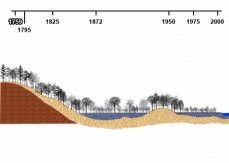Transcription of video clip Past relationships: yesterdayâs Earth
Haut-Saint-Laurent forest landscape, following the 1759 British conquest.

© Gérald Domon
In beige, the morainic soils. In blue-gray, the argillaceous plains.
Made from soil and rocks left by glaciers, the morainic soils are covered by hemlock or beech sugar maple forests.
Argillaceous plains, with bad water drainage, are mostly covered by shrubs.
This is the typical Haut-Saint-Laurent pre-colonial vegetation.
At the end of the 18th century, the first settlers colonize river banks.
They harvest oaks and Eastern white pines, which are sought for.
Great Britain needs oak for its shipyards, and pines are needed for Montreal's residential construction.
From 1820 on, settlers change the Haut-Saint-Laurent into an agricultural region.
The morainic soils are deforested to give room for agriculture.
In the woods, hardwoods of all sizes are piled up and burned.
Potash, very lucrative, is extracted from the ashes.
In the last quarter of the 19th century, massive settler influx transforms the Haut-Saint-Laurent into one of Quebecs most agricultural regions.
Agriculture develops everywhere, regardless of the soil nature.
Deforestation is almost total.
In the middle of the 20th century, industrial agriculture specializes on the argillaceous plains.
Morainic soils, mostly abandoned, turn into fallow lands.
Around 1980, agriculture intensifies on the argillaceous plains.
Dairy farms are converted in cereal farms.
Vegetation on the morainic soils, still fallow lands, continues its growth.
Trees reappear in the landscape.

© Gérald Domon
In red, the cereal farms.
At the start of the 21st century, cereal farm expansion continues on the argillaceous plains.
On the morainic soils, the young forests are victims of their success: they attract residential construction.

© Jacques Brisson
Contemporary Haut-Saint-Laurent landscape
Studying landscape history brings to light three conclusions.
Changes, associated with the landscape composition, are very irregular.
They are brought by socio-economic demand for certain resources.
And the available technology determines the exploitable soils for agricultural purposes.
To find long-term solutions to deforestation, we must make sure to learn from those historical lessons.
Back to video clip




